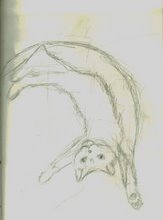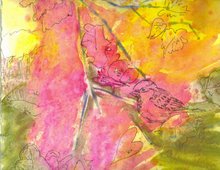Returning from nantucket
Wednesday, July 4, 2012
Monday, March 19, 2012
the Genius of Leonardo DaVinci
DaVinci is my artist hero! As I often ponder DaVinci's brillance, I think a lesson centered on him would be a moment of eductional creative bliss. It is such a shame that so much of his work was lost after his death! Teaching about DaVinci is also an incredibly easy way to be interdisciplinary. Art and science have a symbiotic relationship with eachother and DaVinci easily exemplifies this.
I would give handouts of his art, discoveries and inventions as independent experiences from eachother. The lesson would be inclusive of observational drawing, connecting his art to how he influenced science looking specifically at air flight and the Wright Bros. Kitty Hawk flight, and creating our own inventions through draftsmanship.
PBS has a documentry on DaVinci. I would use the documentary and their online supplemental resource to build this lesson into multidimensional unit.
Book Resource:
"Drawing Lessons from the Great Masters" by Robert Beverly Hale.
I would give handouts of his art, discoveries and inventions as independent experiences from eachother. The lesson would be inclusive of observational drawing, connecting his art to how he influenced science looking specifically at air flight and the Wright Bros. Kitty Hawk flight, and creating our own inventions through draftsmanship.
PBS has a documentry on DaVinci. I would use the documentary and their online supplemental resource to build this lesson into multidimensional unit.
Book Resource:
"Drawing Lessons from the Great Masters" by Robert Beverly Hale.
Thursday, March 8, 2012
Dragons!
I really like looking at mythical creatures with young art students (artist of all ages really). Through the mythical creatures lesson, I like to look at storytelling across diverse cultures and histories. I like to relate the roles of storytellers and artists, and look at illustrators and comic artists who create contemporary mythic creatures. (This also relates well to the printmaking lesson and manga.) Through this lesson, I introduce the idea of the rule of 3 in art and writing.
When I was student teaching, the Museum of Science had a Mythic Creatures exhibit October 2008 to March 2009 which I still use as a resource in teaching this art lesson: http://www.mos.ord/exhibits_show/exhibit_archive&d=2674
There is also a link to additional resource through the American Natural History Museum.
I think understanding anatomy is important, and it is easy to give a rudimentary knowledge of skeletal systems. Also, understanding the inside of the subject as well as the surface is a key element to being a good artist.
Students can choose to create their own dragon or draw one from mythology around the world.
Lessons
Draw the skull of your dragon.
Draw the skeleton of the dragon.
Design the dragon's environment using foreground, middle ground, background. Place your dragon in this environment performing an action. Show beginning, middle, and end, in other words, introduction, climax/conflict, conclusion.
Additional Media Techniques the can be considered:
Water color resist
Printmaking
3D papier mache
Clay
When I was student teaching, the Museum of Science had a Mythic Creatures exhibit October 2008 to March 2009 which I still use as a resource in teaching this art lesson: http://www.mos.ord/exhibits_show/exhibit_archive&d=2674
There is also a link to additional resource through the American Natural History Museum.
I think understanding anatomy is important, and it is easy to give a rudimentary knowledge of skeletal systems. Also, understanding the inside of the subject as well as the surface is a key element to being a good artist.
Students can choose to create their own dragon or draw one from mythology around the world.
Lessons
Draw the skull of your dragon.
Draw the skeleton of the dragon.
Design the dragon's environment using foreground, middle ground, background. Place your dragon in this environment performing an action. Show beginning, middle, and end, in other words, introduction, climax/conflict, conclusion.
Additional Media Techniques the can be considered:
Water color resist
Printmaking
3D papier mache
Clay
Wednesday, March 7, 2012
a musing of an artist bibliography
Drawing on the Right Side of the Brain, Betty Edwards
Drawing on the Artist Within, Betty Edwards
The Artist's Way, Julia Cameron
Vein of Gold, Julia Cameron
Why Cats Paint, Heather Busch and Burton Silver
Thinking with Type, Ellen Lupton
Inside/Outside, Malcolm Grear
Creating with Corrugated Cardboard, Rolf Hartung
Cyclopedia Anatomicae, Gyorgy Feher
Drawing on the Artist Within, Betty Edwards
The Artist's Way, Julia Cameron
Vein of Gold, Julia Cameron
Why Cats Paint, Heather Busch and Burton Silver
Thinking with Type, Ellen Lupton
Inside/Outside, Malcolm Grear
Creating with Corrugated Cardboard, Rolf Hartung
Cyclopedia Anatomicae, Gyorgy Feher
Perspective, architecture and civics
I used the PBS Teacher's Resource as the spine of my middle school art perspective lesson: Math and the President: the Blue Room.
By looking at the unusual shape of the Blue Room in the White House, I am able to compare styles across cultures and history while bringing attention to the special role art has in creating cultural identity and the practical application of aesthetic as expressed through mathematical expressions.
I also like to look at the golden ratio, phi, in architecture and show real examples in the class room such as doorways and windows as traditional expressions of the ratio 1.618.
Then, we draw our cities, neighborhoods, rooms using the artistic principles of horizon line, vanishing point
Art Terms
Perspective (1point, 2 point)
Symmetry
Golden ratio
Horizon line
Vanishing point
Tools
pencil, eraser and ruler
Media experience and development can vary.
By looking at the unusual shape of the Blue Room in the White House, I am able to compare styles across cultures and history while bringing attention to the special role art has in creating cultural identity and the practical application of aesthetic as expressed through mathematical expressions.
I also like to look at the golden ratio, phi, in architecture and show real examples in the class room such as doorways and windows as traditional expressions of the ratio 1.618.
Then, we draw our cities, neighborhoods, rooms using the artistic principles of horizon line, vanishing point
Art Terms
Perspective (1point, 2 point)
Symmetry
Golden ratio
Horizon line
Vanishing point
Tools
pencil, eraser and ruler
Media experience and development can vary.
Saturday, October 3, 2009
Thesis Bibliography
Campbell, J., (1972). The Hero with a Thousand Faces. Princeton: Princeton University Press.
Campbell, J., & Abadie, M. (1974). The Mythic Image. Princeton: Princeton University Press.
Kris, E., & Kurz, O. (1979). Legend, Myth, and Magic in the Image of the Artist. New Haven: Yale University Press.
Lester, P. (1995). The biographical directory of Native American painters. Tulsa: SIR Publications.
Penn, W. S. (1996). Telling of the World: Native American Stories and Art. Abrams.
Rothko, M., Prizel, K., & Rothko, C. (2004). The Artist's Reality. New Haven: Yale University Press.
Rushing, W., (1999). Native American Art in the Twentieth Century. New York: Routledge.
Articles *
Farris, Phoebe. Feminist studies : FS.: Contemporary Native American Women Artists: Visual Expressions of Feminism, the Environment, and Identity
Walkup, N. SCHOOL ARTS: Native American Women Artists Online
Exhibition Catalogue *
Watchful eyes : Native American women artists / [guest curator, Theresa Harlan ; editing, Anne Gully].
and
Myth, sterotype, taboo, and the self-esteem of the woman artist, a thesis in art education by Kathleen Edith Connors.
Children's Story *
The Children of the Morning Light : Wampanoag tales
Campbell, J., & Abadie, M. (1974). The Mythic Image. Princeton: Princeton University Press.
Kris, E., & Kurz, O. (1979). Legend, Myth, and Magic in the Image of the Artist. New Haven: Yale University Press.
Lester, P. (1995). The biographical directory of Native American painters. Tulsa: SIR Publications.
Penn, W. S. (1996). Telling of the World: Native American Stories and Art. Abrams.
Rothko, M., Prizel, K., & Rothko, C. (2004). The Artist's Reality. New Haven: Yale University Press.
Rushing, W., (1999). Native American Art in the Twentieth Century. New York: Routledge.
Articles *
Farris, Phoebe. Feminist studies : FS.: Contemporary Native American Women Artists: Visual Expressions of Feminism, the Environment, and Identity
Walkup, N. SCHOOL ARTS: Native American Women Artists Online
Exhibition Catalogue *
Watchful eyes : Native American women artists / [guest curator, Theresa Harlan ; editing, Anne Gully].
and
Myth, sterotype, taboo, and the self-esteem of the woman artist, a thesis in art education by Kathleen Edith Connors.
Children's Story *
The Children of the Morning Light : Wampanoag tales
Sunday, October 19, 2008
Subscribe to:
Comments (Atom)





















